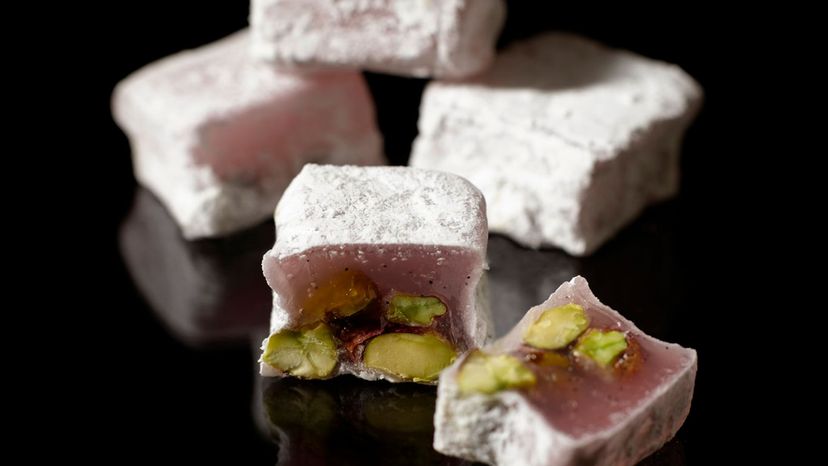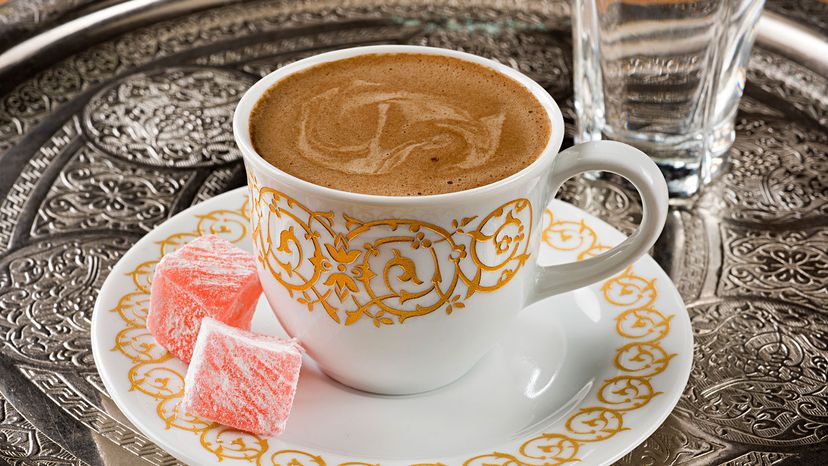 “Turkish delight is a super-sweet confection from the country of Turkey. See our recipe in this article to try making it. The Culinary Institute of America
“Turkish delight is a super-sweet confection from the country of Turkey. See our recipe in this article to try making it. The Culinary Institute of America
If you’ve ever read "The Lion, The Witch and The Wardrobe" (or watched any of its television or film incarnations) you probably marveled when the character Edmund Pevensie basically sold his soul to the witch for a taste of his very favorite treat, Turkish delight. That must be some seriously delicious dessert, right?
If you’re not a fan of jelly candies like Swedish fish or gummy bears, you likely won’t enjoy Turkish delight. "If you have no reference point it would be easiest to compare it to a gumdrop," explains chef Stephen Durfee, professor of baking and pastry arts at The Culinary Institute of America. "It’s not a dessert so much as a candy or confection," he adds.
As its name might indicate, Turkish delight is a super-popular, super-sweet confection from the country of Turkey. There, it’s more commonly known as lokum, and the first incarnation dates back to around the late 1700s. The sweet, which is often given as a hospitality gift, was likely invented by a confectioner named Bekir Effendi. His creation was so beloved by the sultan at the time that he was appointed chief confectioner. In Turkey, the sweet is often served with coffee or tea.
Turkish delight, like many gummy candies, starts off by boiling sugar and water to make a sugar syrup. Then, it is thickened using cornstarch, which sets it apart from many chewy candies. "It has a set gel type of texture, which is very different from anything set with gelatin or agar-agar [a jelly-like substance]," says Rory Macdonald, pastry chef at the Institute of Culinary Education, in an email. "It is very smooth and pleasant to eat and is typically available in many different flavors. It is sometimes covered with chocolate."
The sticking point for even adventurous Western eaters is that the flavors are not what they’re used to. Instead of fruit or chocolate flavoring, floral notes are used instead in the confection, such as rosewater, orange blossom or even mastic, which is tree resin. The latter, "almost reminds you of turpentine; it sounds horrible, but it’s actually not," says Durfee, adding that it’s very cleansing and thus good for digestion.
 “Turkish delight is often served with coffee or tea in Turkey.BURCU ATALAY TANKUT/Getty Images
“Turkish delight is often served with coffee or tea in Turkey.BURCU ATALAY TANKUT/Getty Images
Turkish delight is certainly not a healthy option, though. A small 1.4 ounce (40 gram) serving of the treat packs 32 grams of sugar and zero nutritional value. "It’s pretty much all sugar, plus the flavorings and additions," says Macdonald. Additions often include nuts such as pistachios or almonds. Turkish delight is typically dusted with powdered sugar to keep the cubes from sticking together.
Making Turkish Delight
Although it doesn’t include very many ingredients, Turkish delight is pretty tricky to make at home. This is in part because the cornstarch available in stores is a different strength from the cornstarch used commercially. As a result, it takes a long time to cook. "Trying to make it at home with conventional cornstarch is more labor-intensive," Durfee says. "Over a low temperature with constant stirring you might be in for 45 mins to an hour."
Also, unlike with other confections that are heated to a specific temperature, Turkish delight is cooked until it reaches a certain thickness and holds its shape. This point is very vague, Durfee says. "Only someone who’s done it before would be able to know it’s ready."
Still, the ingredients are cheap, so why not give it a shot? "You just need a pot, sugar water and cornstarch," Durfee explains. If it fails, you haven’t lost "anything but the time. Learn from the experience and try it again!"
Interested in whipping up a batch of this Turkish treat at home? Give this recipe a try!
Turkish Delight
(from "Chocolates and Confections at Home with The Culinary Institute of America" by Peter Greweling). Makes one 9- by 13-inch slab
Sugar Syrup
4 cups granulated sugar
1 cup water
1 tsp cream of tartar
Starch paste
1 cup cornstarch
1 tsp cream of tartar
3 cups water
Flavoring, Coloring and Inclusions
2 tsp rose water
2 to 3 drops pink or red coloring
1-1/2 cups shelled unsalted undyed pistachios
Coating
1/2 cup confectioners’ (powdered) sugar
1/4 cup cornstarch
- Lightly oil a 9 × 13–inch baking pan, line with plastic wrap and oil the wrap. Set aside.
- Combine the sugar, water and cream of tartar for the sugar syrup in a 2-quart saucepan. Bring to a boil, cover and allow to boil for 4 minutes without stirring.
- Remove the lid from the pan, insert a thermometer and continue cooking until the sugar reaches 260 degrees F. Remove from the heat, cover and leave undisturbed.
- Mix together the cornstarch, cream of tartar and water for the starch paste in a 4-quart saucepan.
- Stir constantly with a whisk over medium heat until the mixture thickens and boils. (It will be a very pasty, thick mixture.) Continue to stir and cook for 2 to 3 minutes.
- Stream the cooked sugar syrup into the starch paste while whisking on the heat.
- Bring the mixture to a gentle boil and continue whisking and cooking on low heat until the mixture is smooth and clear. This will take 20 to 25 minutes.
- Remove from the heat, stir in the rose water, coloring and pistachios.
- Pour into the prepared pan, lay a piece of plastic wrap directly on top of the candy and leave it to cool for at least 4 or 5 hours, or overnight.
- Sift together the confectioners’ sugar and cornstarch for the coating. Cut the candy into the desired size pieces and roll in the coating mixture.
- Store airtight at room temperature.
HowStuffWorks earns a small affiliate commission when you purchase through links on our site.
Now That’s Cool
No matter what your individual nutrition restrictions are, you can probably have Turkish delight, Macdonald says. "This is a great treat for anyone who can’t have sweet things due to allergies or dietary requirements as it is vegan, gluten-free, vegetarian and dairy-free."
Originally Published: Nov 17, 2020
Turkish Delight FAQ
What is a Turkish delight made of?
Turkish delights are a gummy candy that’s made from boiled sugar and water (which creates syrup) mixed with cornstarch and flavoring.
What does a Turkish delight taste like?
Turkish delights are made with a wide variety of different flavors. Some of the most common are rosewater, which has a light rose flavor, and orange flower water, which has a bright, citrusy flavor.
How bad is a Turkish delight for you?
Because Turkish delights are made primarily with sugar, they’re not very healthy. They’re the same as many other popular candies and gummy treats when it comes to their effects on your health.
Where can you get Turkish delights?
You can find Turkish delights at many big box retailers, including online through Amazon.













































